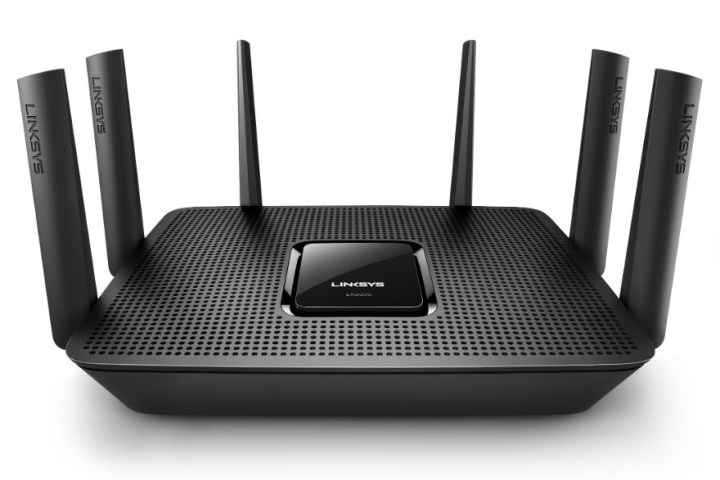
According to Linksys, the stand-alone router is capable of speeds of up to 750Mbps on the 2.4GHz band and up to 1,625Mbps on each 5GHz band. However, to see those maximum speeds, the connecting wireless devices must include three internal antennas to capture the three streams broadcast by the router.
While those numbers sound uncommonly high, consider that the router broadcasts three streams per 2.4GHz/5GHz/5GHz connection (3x3x3). In turn, each stream has a maximum channel width and waveform (modulation). On the 2.4GHz front, a stream with a channel width of 40MHz and a 256-QAM modulation can achieve 200Mbps per second. However, the new router uses a 1024-QAM modulation, increasing the speed to 250Mbps. The 5GHz bands also use a 1024-QAM modulation to hit 541.67Mbps per stream.
Typically, we see devices packing only two internal antennas getting a maximum 2.4GHz speed of 400Mbps and a maximum 5GHz speed of 867Mbps. However, all of these speeds are theoretical anyway, and devices won’t hit those maximum numbers unless the user is in a sterile, interference-free environment. Here’s a more detailed diagram:
2.4GHz @ 750Mbps = 250Mbps + 250Mbps + 250Mbps
| Modulation | Channel Width | Max Speed |
| 64-QAM (5/6) | 40MHz | 150Mbps |
| 256-QAM (5/6) | 40MHz | 200Mbps |
| 1024-QAM (5/6) | 40MHz | 250Mbps |
5GHz @ 1,625Mbps = 541.67Mbps + 541.67Mbps + 541.67Mbps
| Modulation | Channel Width | Max Speed |
| 64-QAM (5/6) | 80MHz | 325Mbps |
| 256-QAM (5/6) | 80MHz | 433.3Mbps |
| 1024-QAM (5/6) | 80MHz | 541.67Mbps |
As for other features, the new router features a quad-core processor clocked at 1.8GHz, 512MB of system memory, 256MB of internal storage, four gigabit Ethernet ports for wired devices, one gigabit Ethernet port for the modem connection, two USB 3.1 Gen1 Type-A ports, and six external antennas.

The CG7500 modem/router hybrid is compatible with Comcast Xfinity and Charter Spectrum broadband services up to 300Mbps. On the wireless front, it’s also a three-stream device, although its speeds aren’t quite as robust. On the 2.4GHz end, the CG7500 reaches up to 600Mbps (3 x 200Mbps), while the 5GHz band reaches up to 1,300Mbps (3 x 433.3Mbps).
The new modem/router combo is based on Intel’s Puma 6 processor built specifically for version 3.0 of the Data Over Cable Service Interface Specification, which is what enables cable TV and broadband data transfers. The chip is “flexible and high-performing,” enabling download speeds of up to 960Mbps even though the modem/router hybrid is locked to 300Mbps broadband plans.
The CG7500 includes four gigabit Ethernet ports, one F-Type female cable connection, and one USB 2.0 port. The device is available now for a one-time purchase price of $200, which eliminates the rental fees associated with using a broadband provider’s modem. The stand-alone EA9300 router is also available for a heftier $300.


